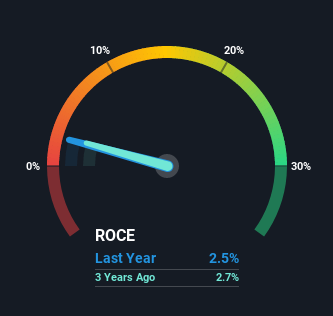- United States
- /
- Electric Utilities
- /
- NYSE:HE
Hawaiian Electric Industries (NYSE:HE) Has Some Way To Go To Become A Multi-Bagger

If we want to find a stock that could multiply over the long term, what are the underlying trends we should look for? Firstly, we'd want to identify a growing return on capital employed (ROCE) and then alongside that, an ever-increasing base of capital employed. If you see this, it typically means it's a company with a great business model and plenty of profitable reinvestment opportunities. Although, when we looked at Hawaiian Electric Industries (NYSE:HE), it didn't seem to tick all of these boxes.
Understanding Return On Capital Employed (ROCE)
For those that aren't sure what ROCE is, it measures the amount of pre-tax profits a company can generate from the capital employed in its business. Analysts use this formula to calculate it for Hawaiian Electric Industries:
Return on Capital Employed = Earnings Before Interest and Tax (EBIT) ÷ (Total Assets - Current Liabilities)
0.025 = US$382m ÷ (US$16b - US$450m) (Based on the trailing twelve months to September 2021).
Therefore, Hawaiian Electric Industries has an ROCE of 2.5%. Ultimately, that's a low return and it under-performs the Electric Utilities industry average of 4.5%.
Check out our latest analysis for Hawaiian Electric Industries

Above you can see how the current ROCE for Hawaiian Electric Industries compares to its prior returns on capital, but there's only so much you can tell from the past. If you're interested, you can view the analysts predictions in our free report on analyst forecasts for the company.
What Can We Tell From Hawaiian Electric Industries' ROCE Trend?
In terms of Hawaiian Electric Industries' historical ROCE trend, it doesn't exactly demand attention. Over the past five years, ROCE has remained relatively flat at around 2.5% and the business has deployed 27% more capital into its operations. This poor ROCE doesn't inspire confidence right now, and with the increase in capital employed, it's evident that the business isn't deploying the funds into high return investments.
In Conclusion...
In summary, Hawaiian Electric Industries has simply been reinvesting capital and generating the same low rate of return as before. Since the stock has gained an impressive 50% over the last five years, investors must think there's better things to come. But if the trajectory of these underlying trends continue, we think the likelihood of it being a multi-bagger from here isn't high.
If you want to know some of the risks facing Hawaiian Electric Industries we've found 2 warning signs (1 makes us a bit uncomfortable!) that you should be aware of before investing here.
While Hawaiian Electric Industries may not currently earn the highest returns, we've compiled a list of companies that currently earn more than 25% return on equity. Check out this free list here.
If you're looking to trade Hawaiian Electric Industries, open an account with the lowest-cost platform trusted by professionals, Interactive Brokers.
With clients in over 200 countries and territories, and access to 160 markets, IBKR lets you trade stocks, options, futures, forex, bonds and funds from a single integrated account.
Enjoy no hidden fees, no account minimums, and FX conversion rates as low as 0.03%, far better than what most brokers offer.
Sponsored ContentValuation is complex, but we're here to simplify it.
Discover if Hawaiian Electric Industries might be undervalued or overvalued with our detailed analysis, featuring fair value estimates, potential risks, dividends, insider trades, and its financial condition.
Access Free AnalysisHave feedback on this article? Concerned about the content? Get in touch with us directly. Alternatively, email editorial-team (at) simplywallst.com.
This article by Simply Wall St is general in nature. We provide commentary based on historical data and analyst forecasts only using an unbiased methodology and our articles are not intended to be financial advice. It does not constitute a recommendation to buy or sell any stock, and does not take account of your objectives, or your financial situation. We aim to bring you long-term focused analysis driven by fundamental data. Note that our analysis may not factor in the latest price-sensitive company announcements or qualitative material. Simply Wall St has no position in any stocks mentioned.
About NYSE:HE
Hawaiian Electric Industries
Engages in the electric utility business in the United States.
Undervalued with moderate growth potential.
Similar Companies
Market Insights
Community Narratives



